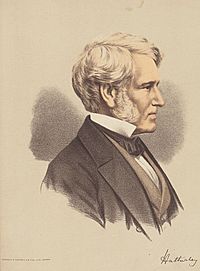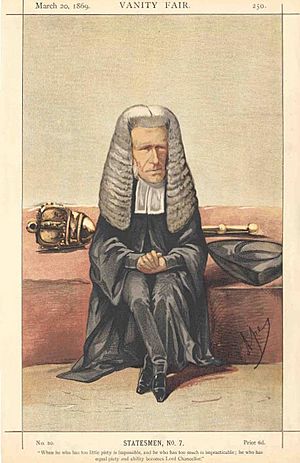William Wood, 1st Baron Hatherley facts for kids
Quick facts for kids
The Lord Hatherley
|
|
|---|---|
 |
|
| Lord High Chancellor of Great Britain | |
| In office 9 December 1868 – 15 October 1872 |
|
| Prime Minister | William Ewart Gladstone |
| Preceded by | The Lord Cairns |
| Succeeded by | The Lord Selborne |
| Personal details | |
| Born | 29 November 1801 London, England |
| Died | 10 July 1881 (aged 79) London, England |
| Political party | Liberal |
| Spouse |
Charlotte Moor
(m. 1830; died 1878) |
| Alma mater | |
William Page Wood, 1st Baron Hatherley (born November 29, 1801 – died July 10, 1881) was an important British lawyer and politician. He was a member of the Liberal Party. From 1868 to 1872, he served as the Lord High Chancellor of Great Britain. This was a very high legal position in the government of William Ewart Gladstone.
Contents
Early Life and Education
William Wood was born in London, England. He was the second son of Sir Matthew Wood, 1st Baronet. His father was an alderman and also served as the Lord Mayor of London. Sir Matthew Wood was well-known for being a friend to Queen Caroline. He even stood up to King George IV for her.
William went to Winchester College for his schooling. However, he was asked to leave after a student protest against the headmaster. He then studied at Woodbridge School and later at Geneva University. He finished his education at Trinity College, Cambridge. In 1824, he became a fellow there.
Becoming a Lawyer and Politician
William Wood started his legal training at Lincoln's Inn. He officially became a lawyer in 1824. He learned about property law from John Tyrrell. Soon, he became very good at drafting legal documents. He also worked on cases for parliamentary committees.
In 1845, he became a Queen's Counsel. This is a special title for experienced lawyers. In 1847, he was chosen to be a Member of Parliament (MP) for the city of Oxford. He represented the Liberal Party.
Rising Through the Ranks
In 1849, William Wood was given the role of Vice-Chancellor of the County Palatine of Lancaster. This was a judicial position. In 1851, he became the Solicitor General for England and Wales. This is a senior legal advisor to the government. He was also made a knight that year. He left the Solicitor General role in 1852.
When his party, the Liberals, came back to power in 1853, he was made a Vice-Chancellor. This was another important judge position.
Becoming Lord Chancellor
In 1868, William Wood became a Lord Justice of Appeal. This meant he was a judge in a higher court. But before the year ended, William Ewart Gladstone chose him for an even bigger role. He was made the Lord High Chancellor of Great Britain. This is one of the highest legal and political offices in the United Kingdom.
When he became Lord Chancellor, he was also given a special title. He became a peer, known as Baron Hatherley. His full title was Baron Hatherley, of Down Hatherley in the County of Gloucester.
He had to retire in 1872 because his eyesight started to fail. Even after retiring, he sometimes helped as a law lord. This meant he could still take part in legal decisions in the House of Lords.
Family Life
William Wood married Charlotte Moor in 1830. They did not have any children. Charlotte passed away in 1878. Her death was very hard for William, and he never fully recovered. He died in London on July 10, 1881, when he was 79 years old. Both William and Charlotte are buried in the churchyard in Great Bealings, Suffolk. Charlotte's brother was a rector (a type of priest) there. When William died, his title of Baron Hatherley ended because he had no children to inherit it.
See also
- Page Wood Baronets
- Pilcher v Rawlins



